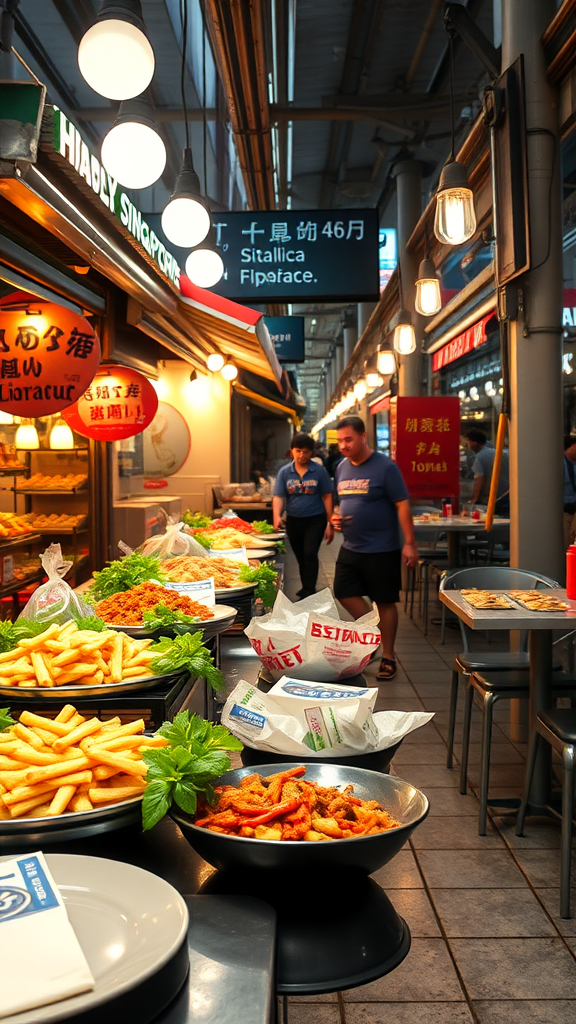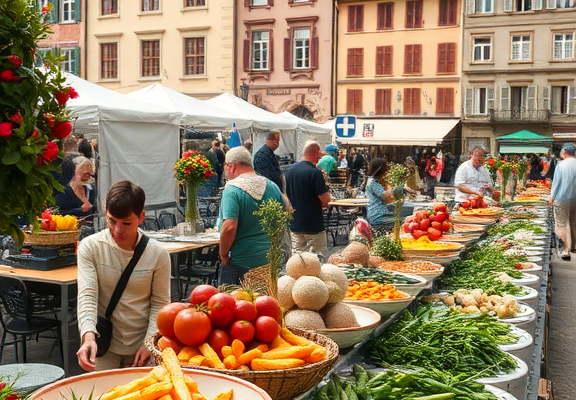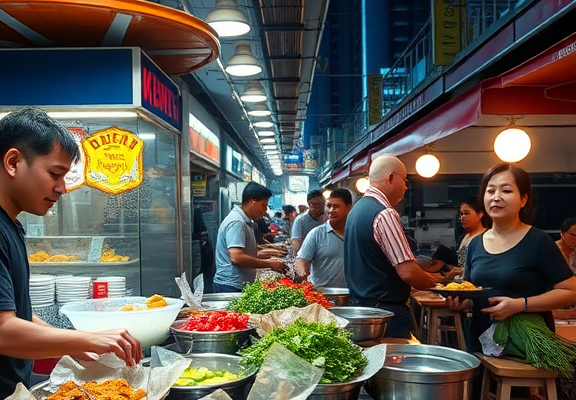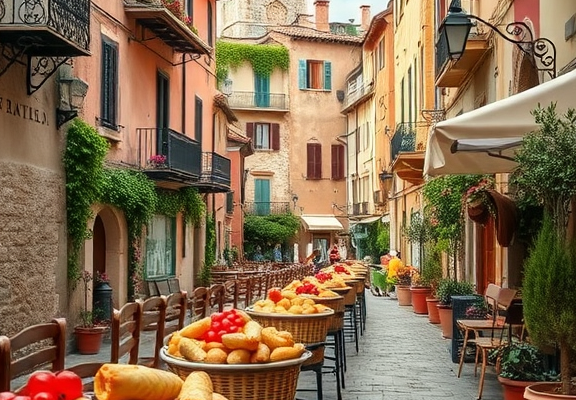Exploring the Rich Tapestry of Street Food vs. Fine Dining in Singapore
Singapore is a melting pot of cultures, a vibrant city where the culinary landscape thrives on diversity. The allure of Singapore’s food scene lies in its unique combination of street food and fine dining, each offering an enriching experience that reflects the city’s rich heritage. As you navigate through this gastronomic paradise, you’ll find yourself captivated by the distinctive charm and flavors both street vendors and upscale restaurants provide.
Thank you for reading this post, don't forget to subscribe!Street food in Singapore is not just a meal; it’s an experience steeped in history. Stalls dotted around the island serve up authentic dishes from various ethnic backgrounds, including Malay, Chinese, Indian, and even Peranakan cuisines. The scents of sizzling satay, spicy laksa, and fragrant chicken rice attract food lovers from all walks of life. You can find street hawkers in bustling neighborhoods like Chinatown, Little India, and Kampong Glam, each presenting a delectable array of options.
The passion for street food is palpable. Here are some beloved dishes that you simply cannot miss:
- Hainanese Chicken Rice: Tender chicken served with fragrant rice cooked in chicken broth.
- Chili Crab: A quintessentially Singaporean dish featuring crab in a spicy and tangy tomato sauce.
- Laksa: A spicy noodle soup with coconut milk, often made with prawns or chicken.
- Char Kway Teow: Stir-fried flat rice noodles tossed with soy sauce, shrimp, Chinese sausage, and bean sprouts.
- Nasi Lemak: Coconut rice served with sambal, fried egg, peanuts, and fried fish.
On the other hand, fine dining in Singapore showcases an array of culinary artistry. These high-end establishments often feature internationally recognized chefs dedicated to creating exquisite dishes that combine local ingredients with global techniques. Dining in one of Singapore’s top-rated restaurants is more than just savoring a meal; it’s an exploration of flavors, presentations, and environments that leave a lasting impression.
Some notable fine dining experiences in the city include:
- Odette: A Michelin-starred restaurant located at the National Gallery of Singapore, renowned for its French cuisine.
- Waku Ghin: Chef Tetsuya Wakuda runs this award-winning restaurant, offering an exquisite Japanese-Italian fusion.
- Les Amis: A fine dining staple celebrated for its exceptional French menu and well-curated wine list.
- Fine dining at Marina Bay Sands: With breathtaking views and innovative dishes, this area has become a hot spot for gourmet enthusiasts.
Both street food and fine dining offer indelible experiences, yet they cater to different moods and moments. When you’re in a hurry, street food provides quick, tasty options that are affordable. Here, you can feel the pulse of the streets, interacting with vendors and locals as you munch on mouth-watering treats. In contrast, fine dining creates an occasion, inviting you to indulge in luxurious surroundings, stellar service, and intricate meal presentations.
Moreover, both culinary styles embody the spirit of Singapore through their flavors. Street food captures the essence of local traditions and influences, while fine dining pushes boundaries, showcasing innovation and creativity. It’s not uncommon to witness dishes that integrate local flavors into international techniques, bridging the gap between the two worlds.
For visitors and locals alike, Singapore’s richness in street food and fine dining serves to unite them through shared experiences. Whether you are seated in a casual hawker center or an elegant Michelin-star establishment, the joy of good food creates stories that bring people together. Each plate tells a story of history, culture, and personal touch, reminding you of the city’s dynamic culinary heritage.
At the end of the day, whether you choose to indulge in the delights of street food or immerse yourself in the charm of fine dining, Singapore offers something for everyone. It’s a celebration of flavors that cater to every palate, each delectable dish reflecting a piece of the city’s vibrant culture. So, why not explore the best of both worlds during your next visit? You will undoubtedly find new favorites that offer a taste of this incredible city’s diverse dining scene.
The Cultural Significance and Evolution of Singapore’s Culinary Landscape
Singapore stands as a vibrant melting pot of cultures, each contributing to a rich tapestry that defines its culinary landscape. The exploration of the culinary scene reveals not just flavors and aromas, but also the story of a nation shaped by its diverse heritage. The evolution of Singapura’s food scene mirrors the history and the collective experience of its people.
Food in Singapore is not merely sustenance; it serves as a cultural bridge. The dining experience brings together local and global communities, offering an avenue for sharing traditions, stories, and identities. The city-state’s historical timeline reveals how culinary influences have been adopted and adapted, resulting in a unique fusion.
One significant aspect is the role of street food. It is not just a quick meal for many; it embodies the daily life of Singaporeans. Hawker centers are famous symbols of Singaporean culture, offering an affordable way for people to experience a myriad of dishes, such as:
- Chicken Rice
- Laksa
- Nasi Lemak
- Char Kway Teow
- Satay
These dishes reflect the combined influences of Malay, Chinese, and Indian cuisines, showcasing how different cultures are harmoniously intertwined. Also, street food vendors often have recipes passed down through generations, adding layers of personal significance to the food they serve. Each bite tells a story of tradition, family, and community. Street food in Singapore has an energy all its own, where the chatter of customers and sizzling of woks in the background create a lively atmosphere.
On the other hand, fine dining in Singapore has risen to prominence, particularly in recent years. Establishments with Michelin stars and acclaimed chefs symbolize a shift towards high culinary art. Fine dining offers a different experience that emphasizes taste, presentation, and technique. Restaurants such as:
- Odette
- Burnt Ends
- Les Amis
- Jaan
Are not just places to eat; they provide an evening of entertainment and cultural expression. In these settings, diners can experience dishes crafted with precision, using high-quality local ingredients. This has birthed a new appreciation for gastronomy in Singapore, drawing food enthusiasts from around the globe. Fine dining also highlights the creativity of chefs who honor traditional recipes while introducing modern techniques.
Moreover, as Singapore continues to evolve, there is a growing trend of culinary innovation. Chefs and restaurants are increasingly incorporating sustainable practices and fusion elements. Local ingredients are being prioritized, allowing patrons to engage with the essence of Singapore’s geography and agriculture. This progressive approach is reflected in contemporary Asian and international cuisine that flourishes within Singapore.
The future of Singapore’s culinary landscape is promising. The fusion of street food and fine dining continues to inspire culinary enthusiasts, as these two worlds coexist and enhance one another. More chefs are taking to the streets to learn from hawkers, bridging the gap between casual and gourmet. The connection between patrons and the chefs who serve them fosters a deeper understanding of the cultural significance behind each dish.
Moreover, food festivals and events like the Singapore Food Festival celebrate this journey of evolution. These events allow chefs, hawkers, and food lovers to come together, share their passion for food, and keep the culinary traditions alive. They create a space where innovation meets tradition, showcasing the dynamic nature of Singapore’s dining scene.
The culinary landscape of Singapore is a reflection of its people, history, and cultural significance. Whether you prefer the bustling atmosphere of hawker centers or the elegant ambiance of fine dining, each experience offers insights into the multifaceted identity of the nation. Ultimately, Singapore’s ongoing evolution in food culture highlights the importance of embracing diversity while celebrating culinary heritage.
Conclusion
Singapore’s culinary scene is a vibrant blend of street food and fine dining, each offering a unique perspective on the nation’s diverse culture. Street food serves as a testament to the everyday lives of locals, showcasing traditional flavors and cooking techniques passed down through generations. These bustling hawker centers not only highlight the culinary heritage of Singapore but also foster community spirit, where families and friends gather to enjoy affordable and delicious meals.
On the other hand, fine dining represents the evolution of Singapore’s gastronomy, emphasizing creativity and innovation. With world-renowned chefs pushing boundaries and crafting exquisite dishes, fine dining establishments attract both locals and tourists seeking a memorable culinary experience. These restaurants often fuse international influences with local ingredients, creating a new wave of cuisine that showcases Singapore’s culinary evolution.
Both street food and fine dining play crucial roles in Singapore’s identity. While they might seem worlds apart, they are united by passion and a commitment to excellence. Each dining experience offers insight into Singapore’s rich cultural tapestry, from the sizzling woks of the hawker stalls to the elegantly plated meals in upscale restaurants. By embracing both sides of this spectrum, you can explore the heart of Singapore’s food culture—an invitation to thrill your taste buds and immerse yourself in the stories behind each dish.
Whether you crave the comfort of satay skewers or the artistic flair of a gourmet meal, Singapore truly has something for everyone. The next time you find yourself wandering the streets or relaxing in a chic dining establishment, remember that both street food and fine dining contribute to a rich culinary journey worth savoring.






